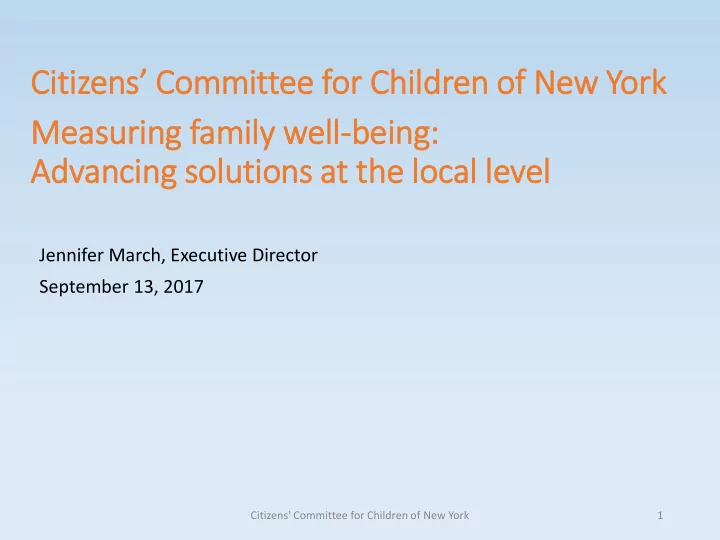

Citizens’ Committee for Children of New York Measuring family well-being: Advancing solutions at t th the lo local le level Jennifer March, Executive Director September 13, 2017 Citizens' Committee for Children of New York 1
Who We Are • Since 1944, Citizens' Committee for Children of New York, Inc. (CCC) has convened, informed, and mobilized New Yorkers to make the city a better place for children. • CCC has spent the last seven decades developing and refining an approach to child advocacy that is fact-based. • CCC's mission is to ensure that every New York child is healthy , housed , educated and safe . Citizens' Committee for Children of New York 2
Who are New York City’s Children? Citizens' Committee for Children of New York 3
There ar are over 1.8 1.8 mill illion ch child ildren in in Ne New York City ity, representin ing more th than 20 20% of of th the tot otal l pop opula lation. Citizens' Committee for Children of New York 4
Ne Nearly on one ou out th three ch child ildren in in NY NYC is is under th the ag age of of 5. 5. NYC Children by Age Group 15.6% 31.6% 26.2% 26.7% Under 5 5 to 9 10 to 14 15 to 17 Citizens' Committee for Children of New York 5
New York City’s children are racially and ethnically diverse, but most in indiv ivid idual l community dis istricts do o not ot refle lect th this is div iversity. Race/Ethnicity of NYC Children 4.2% 25.8% 35.2% 22.8% 12.0% White, non-Hispanic Black, non-Hispanic Asian Latino Other Citizens' Committee for Children of New York 6
Ne Nearly on one ou out of of th three NY NYC ch child ildren is is in in a a si single le-parent hou ousehold ld, in inclu cludin ing up to o 60 60% of of ch child ildren in in so some dis istricts. Household Head of NYC Children 4.9% 9.2% 5.4% 53.6% 26.9% Married couple family Single Mother Single Father Grandparent Other Citizens' Committee for Children of New York 7
Ne Nearly 3 3 ou out of of 10 10 NY NYC ch child ildren liv live in in poverty, in inclu cludin ing 13 13% who liv live in in deep poverty. The ch child ild poverty rate exceeds 50 50% in in so some dis istricts. Income Level of NYC Children 12.5% 24.6% 16.0% 23.2% 23.7% Deep poverty (<50% fpl) Poverty (<100% fpl) Near poor (<200%fpl) Moderate income (btwn 200 and 400% fpl) Higher income (>400% fpl) Citizens' Committee for Children of New York 8
Keeping Track of New York City’s Children Largest municipal-level database of child well-being indicators • Hundreds of indicators: demographics, economic conditions, housing and community, health, education, early education and after-school, child welfare, juvenile justice, teens and youth • Citywide, 5 boroughs, 59 community districts • Racial/ethnic and other demographic disaggregation Citizens' Committee for Children of New York 9
Keeping Track of New York City’s Children Available online at http://data.cccnewyork.org Citizens' Committee for Children of New York 10
CCC’s Community Risk Ranking illustrates where risks concentrate geographically – both overall and within each domain: ECONOMIC SECURITY EDUCATION • Child Poverty Rate • Early Education • Median Income for Enrollment Families with Children • Common Core ELA • Parental Employment and Math Test Pass Instability Rate • High School HOUSING Graduation Rate • Rent Burden • Rental Overcrowding YOUTH • Families Entering • Teen Birth Rate Homeless Shelters • Teen Idleness • Youth Unemployment HEALTH • Infant Mortality Rate FAMILY & COMMUNTY • Low Birth Weight • Children in Single- Babies Parent Families • Children without • Adult Educational Health Insurance Attainment • Violent Felony Rate Citizens' Committee for Children of New York 11
Economic Security Indicators: Child poverty rate, Median income for families with children, Parental employment instability Murray Hill/ Stuyvesant (M06) Brownsville (K16) 12
Housing Indicators: Families entering homeless shelter, Rent burden, Rental overcrowding University Heights (B05) Murray Hill/ Stuyvesant (M06) 13
Health Indicators: Infant mortality rate, Low birthweight babies, Children without health insurance Borough Park (K12) Brownsville (K16) 14
Education Indicators: Early education enrollment, ELA/Math test pass rate, High school graduation rate Hunts Point (B02) Battery Park/ Tribeca (M01) 15
Youth Indicators: Teen birth rate, Teen idleness, Youth unemployment Mott Haven (B01) Battery Park/ Tribeca (M01) 16
Family and Community Indicators: Children in single-parent families, Adults without a high school degree, Violent felony rate Hunts Point (B02) Upper East Side (M08) 17
In February, CCC launched a new version of Keeping Track Online that includes an asset mapping function. The list to the right is just a start – we will continue to add new assets as they are identified and as data becomes available. 18 Citizens' Committee for Children of New York
Asset mapping allows us to explore the presence – or absence – of fundamental resources at the neighborhood level. Banks and Food Retail in and around the neighborhood of Brownsville Citizens' Committee for Children of New York 19
Today’s workgroups Morning Session Exploring local data: Environmental factors, community resources and assets that shape family well being. • Examine risk factors that are barriers to well being in the five boroughs at the community district level • Explore the availability of assets or resources that may or may not be present to address needs and reduce barriers to well being Afternoon Session Supporting family well being: Using science to inform practice and policy. • Inform improvements in practice to relieve or reduce key stressors • Advance programming that supports the development of core capabilities • Create service delivery environments that help people take advantage of available services Citizens' Committee for Children of New York 20
Recommend
More recommend